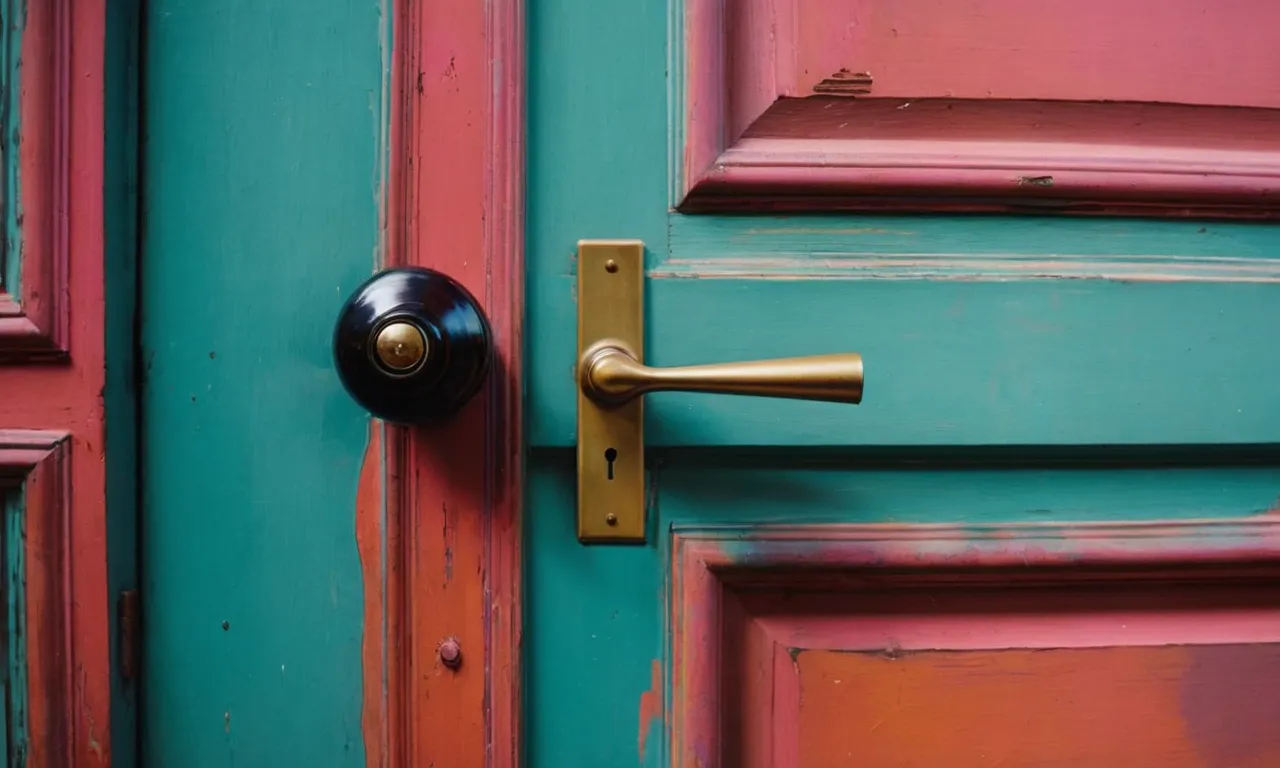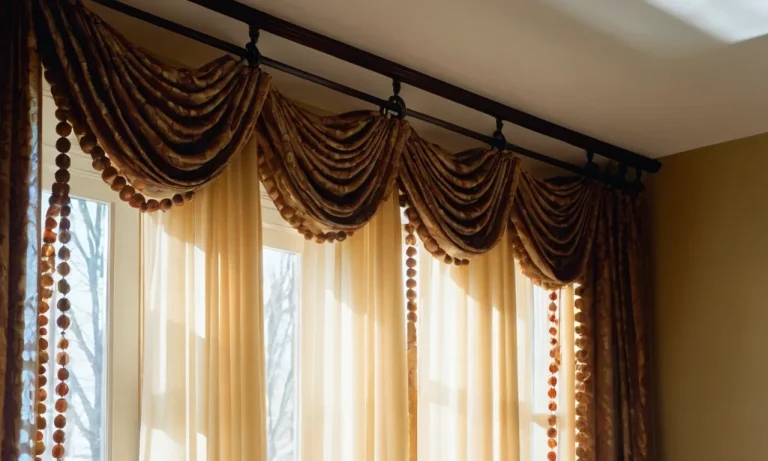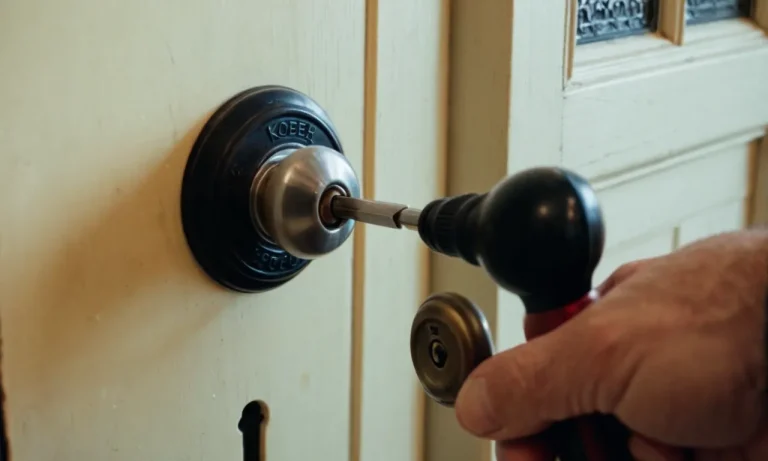What Is A Dummy Door Knob? A Comprehensive Guide
Door knobs are one of those things that most people don’t think twice about – until they stop working properly. If your door knob is loose, sticking, or just plain frustrating to use, a dummy door knob may be the perfect solution.
In short, a dummy door knob is a non-functioning door knob used for aesthetic purposes only. Unlike regular operational door knobs, dummy knobs don’t latch or lock the door. They simply sit in place, giving the appearance of a working door knob without any of the mechanical parts.
In this comprehensive guide, we’ll cover everything you need to know about dummy door knobs, including:
What Exactly is a Dummy Door Knob?
A dummy door knob is a type of door hardware that is designed to appear like a fully functional door knob, but does not actually turn or latch. It is typically used for decorative purposes or to create a symmetrical look on double doors where only one door is operable.
Dummy door knobs are commonly found in homes, hotels, and commercial buildings.
Definition and Key Characteristics
A dummy door knob consists of a knob or lever mounted on a plate or rosette, which is attached to the surface of the door. Unlike a standard door knob, a dummy door knob does not have an internal mechanism for turning or latching. It is simply fixed in place and does not have any functionality.
Dummy door knobs are available in various styles, finishes, and designs to match the aesthetic of the door and the overall decor of the space.
Differences from Standard Door Knobs
The main difference between a dummy door knob and a standard door knob is their functionality. While a standard door knob can be turned to open or close a door, a dummy door knob is non-operable. It is important to note that dummy door knobs cannot be used as a primary entry or exit point, as they do not provide any security or locking mechanism.
They are purely decorative and used to enhance the appearance of a door.
Common Types of Dummy Knobs
There are several common types of dummy door knobs available in the market:
- Single-Sided Dummy Knobs: These dummy knobs are mounted on one side of the door and are typically used on doors that do not require any latching or locking.
- Double-Sided Dummy Knobs: These dummy knobs are mounted on both sides of the door and are commonly used on double doors to create a symmetrical look.
- Surface-Mount Dummy Knobs: These dummy knobs are mounted directly on the surface of the door, without the need for any additional drilling or installation.
It is important to choose the right type of dummy door knob based on your specific needs and the style of your door. Whether you are looking to add a touch of elegance or achieve a balanced aesthetic on your double doors, a dummy door knob can be a great choice.
For more information on dummy door knobs and other types of door hardware, you can visit www.homedepot.com or www.lowes.com.
When to Use a Dummy Door Knob
There are several situations where using a dummy door knob can be beneficial. Whether you are looking to enhance the aesthetics of your space or need a functional solution, a dummy door knob can come in handy. Here are some common scenarios when using a dummy door knob is recommended:
For Strictly Decorative Purposes
If you have a door that does not require a functioning knob but you still want to add a touch of elegance or style, a dummy door knob is the perfect choice. It can be used as an attractive decorative element, creating a cohesive look throughout your home.
You can choose from a variety of designs, finishes, and materials to match your existing décor and personal taste.
When Standard Knob Won’t Fit
Sometimes, the space or design of a door does not allow for a standard door knob to be installed. This can be the case with certain types of doors, such as French doors or double doors, where a traditional knob would interfere with the operation or aesthetics.
In such situations, a dummy door knob can be used as a practical alternative. It provides the appearance of a functioning knob without hindering the functionality of the door.
On Closet Doors
Closet doors often do not require a functional knob, as they are not meant to be locked or secured. Instead, they are primarily used for privacy or to hide clutter. Installing a dummy door knob on closet doors can add a polished look to your space while maintaining the convenience of easy access.
It is a cost-effective solution that allows you to customize the appearance of your closet doors without the need for a traditional lock or latch.
Benefits of Installing Dummy Door Knobs
When it comes to door hardware, dummy door knobs have gained popularity for their numerous benefits. Whether you are looking to enhance the visual appeal of your home or create consistency in your interior design, dummy door knobs offer a practical solution.
Additionally, they are cost-effective and require minimal maintenance. Let’s take a closer look at these advantages:
Enhanced Visual Appeal
One of the main benefits of installing dummy door knobs is the enhanced visual appeal they bring to your home. These decorative door knobs come in a variety of styles, finishes, and designs, allowing you to choose one that complements your overall interior décor.
Whether you prefer a sleek, modern look or a more traditional and ornate design, you can find a dummy door knob that perfectly suits your taste. By adding these stylish accents to your doors, you can instantly elevate the aesthetic appeal of any room.
Creates Consistency
Installing dummy door knobs throughout your home creates a sense of consistency and cohesion in your interior design. By using the same style of door knob in every room, you can achieve a unified look that ties all the elements together.
This is particularly beneficial in open-concept spaces or homes with an interconnected layout. By having cohesive door hardware, you can create a seamless flow from one room to another, enhancing the overall design and creating a harmonious atmosphere.
Cost Effective
Dummy door knobs are a cost-effective alternative to functional door knobs. Since they are not connected to the door’s latching mechanism, they are typically less expensive than their functional counterparts.
This makes them an ideal option for areas where door knobs are purely decorative and do not require locking or unlocking. By choosing dummy door knobs, you can save money without compromising on style or quality.
Easy Maintenance
Maintaining dummy door knobs is incredibly easy. Unlike functional door knobs that require regular lubrication and adjustment, dummy door knobs are simply attached to the surface of the door and do not have any moving parts. This means you don’t have to worry about tightening screws or oiling hinges.
Cleaning them is as simple as wiping them down with a damp cloth to remove any dust or smudges. With minimal maintenance required, dummy door knobs are a hassle-free choice for homeowners.
Buying Considerations for Dummy Door Knobs
Material
When choosing a dummy door knob, one of the first considerations to keep in mind is the material. Dummy door knobs are available in a variety of materials, including brass, stainless steel, bronze, and glass. Each material has its own unique characteristics and aesthetic appeal.
Brass, for example, is known for its durability and classic look, while glass knobs can add a touch of elegance to any door. Consider the style of your home and personal preference when selecting the material for your dummy door knob.
Design and Finish
The design and finish of a dummy door knob can greatly impact the overall look of your door. There are numerous design options available, ranging from traditional to modern. You can choose from various shapes, such as round, oval, or square, depending on your personal preference and the style of your home.
Additionally, consider the finish of the door knob, as it can enhance the aesthetic appeal. Popular finishes include brushed nickel, oil-rubbed bronze, and polished chrome. Take the time to find a design and finish that complements your door and enhances the overall appearance of your space.
Diameter
Another important consideration when purchasing a dummy door knob is the diameter. The diameter of the door knob determines its size and can have an impact on its functionality and appearance. Measure the thickness of your door to ensure that the dummy door knob you choose will fit properly.
Standard door knob diameters typically range from 2 to 2.5 inches. It’s essential to select a door knob with the appropriate diameter to ensure a secure fit and proper functionality.
Quality and Durability
Investing in a high-quality dummy door knob is crucial for long-lasting durability and functionality. Look for door knobs that are made from sturdy materials and have a reputation for being reliable. Reading customer reviews and researching reputable brands can help you make an informed decision.
A high-quality dummy door knob should be able to withstand regular use without wearing out or becoming loose. Additionally, consider any warranties offered by the manufacturer, as this can provide peace of mind and assurance of the product’s quality.
By considering these important factors, you can confidently select a dummy door knob that suits your style, matches your door, and provides reliable functionality for years to come.
How to Install a Dummy Door Knob
What You’ll Need
Before you begin installing a dummy door knob, make sure you have the necessary tools and materials. Here’s a list of what you’ll need:
- A dummy door knob set
- A screwdriver
- A tape measure
- A pencil
- A drill (if needed)
Removing the Existing Knob
If you already have a door knob in place, you’ll need to remove it before installing the dummy knob. Follow these steps:
- Use a screwdriver to remove the screws on the faceplate of the existing door knob.
- Once the screws are removed, gently pry the faceplate and the knob away from the door.
- Set aside the old door knob and faceplate for future use or disposal.
Installing the Dummy Knob
Now that you have removed the existing knob, it’s time to install the dummy door knob. Here’s how:
- Start by determining the desired height for the dummy knob. Use a tape measure to measure the distance from the floor to the center of the existing door knob hole.
- Using a pencil, mark the desired height on the door.
- Place the backplate of the dummy knob against the door, aligning it with the pencil mark.
- Insert the screws into the holes on the backplate and use a screwdriver to tighten them.
- Attach the knob to the backplate, following the manufacturer’s instructions.
And there you have it! You have successfully installed a dummy door knob. Now you can enjoy the aesthetic appeal of a door knob without the functionality. If you need further assistance or want to explore more options, check out Home Depot or Lowe’s for a wide selection of dummy door knobs.
Conclusion
Dummy door knobs offer a simple yet effective solution when you need an attractive knob that doesn’t actually operate. By understanding when and where to use dummy knobs, choosing the right design, and installing them properly, you can easily enhance the look of your doors without breaking the bank.
So next time your door knobs are driving you crazy, consider replacing them with dummy knobs for a decorative no-fuss option. Just use this comprehensive guide to make sure you get the right fit and finish for your home’s unique style.







